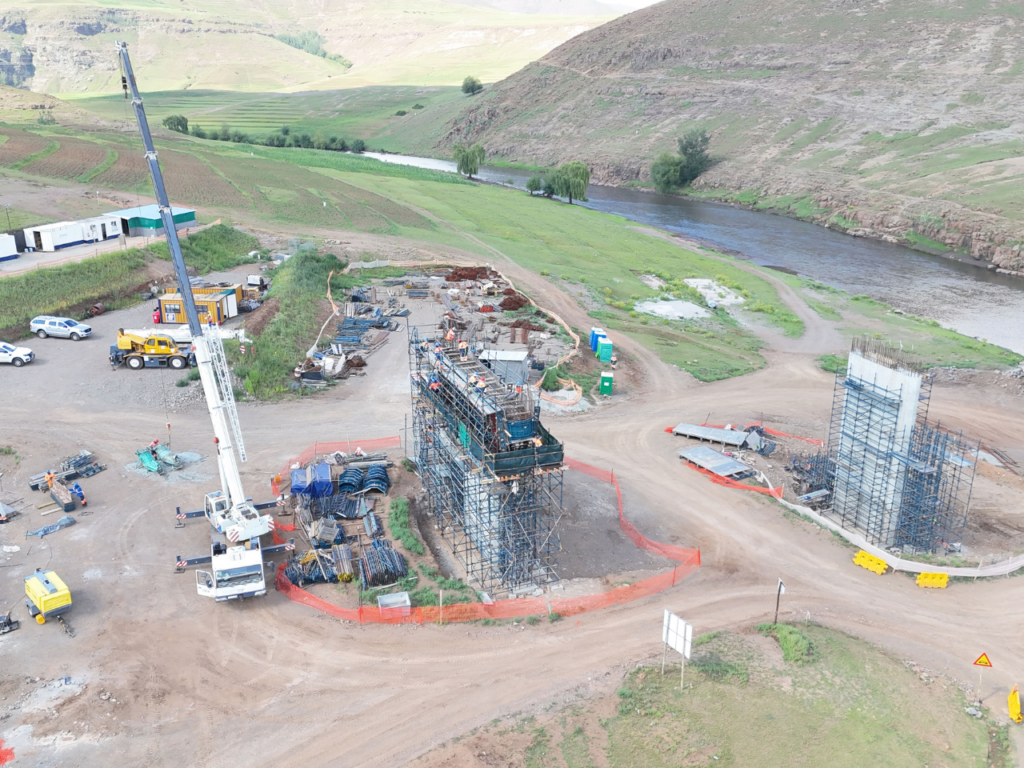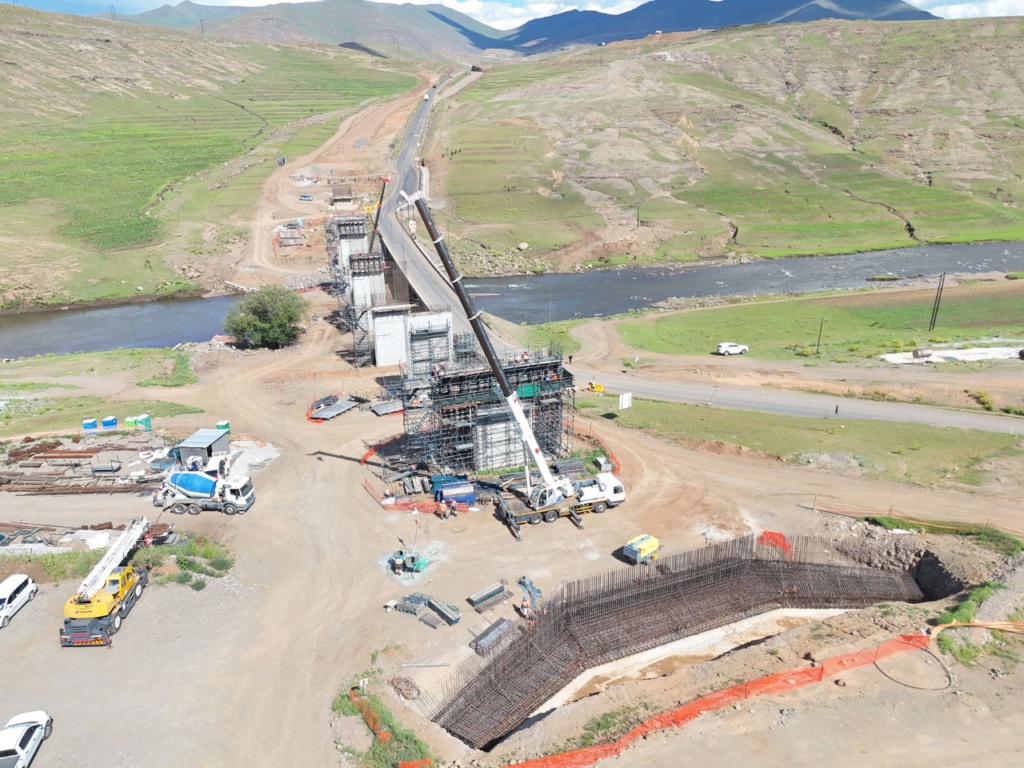Work is surging ahead on the two bridges over the Mabunyaneng and Khubelu Rivers, part of the Polihali Dam programme of the Lesotho Highlands Water Project Phase II.
Driving this progress is the Concor-Nthane Brothers M&K Bridges Joint Venture, which began work in January 2024 on the two structures. The bridges will provide crucial access to the town of Mokhotlong once the existing roads and tracks are inundated by the Polihali reservoir. The road network is being realigned to accommodate the expected full supply water level of this dam. In terms of dimensions, the Khubelu Bridge will comprise nine spans of 30 m each, making up a 270 m stretch across the Khubelu River. The bridge across the Mabunyaneng River is 120 m long with four 30 m spans. Both bridges will have two abutments and will be 13,5 m wide. Located in the higher regions of the valleys, the bridges will be 30 to 35 m above ground level. According to Concor Contracts Manager Jaco Verreynne, much of the work to date has been creating the foundation structures for the bridges.
“There has been a more or less even spread of piling and founding on competent rock,” says Verreynne. “The basic design includes standard pillar type piers, with a pier head to receive the precast beams, completed by a reinforced concrete deck.”

The pier head ready for the start of readymix concrete pours at Khubela Bridge.
At the Khubelu Bridge, piers are dowelled into competent rock while the abutments each receive 12 piles. While the one abutment on the Mabunyaneng Bridge is on competent rock and can be dowelled, the other will be piled – as with the piers. He notes that the pile depth is between 8 m and 12 m. “We drive a metal casing through the soft material after which the drilling can be conducted through the casing,” he says. “Once we reach the required rock strength, we can socket into this competent material. Steel reinforcement is then put in place, followed by the casting of concrete using the tremie method, ensuring that the concrete does not segregate.” Rivers have been relatively low during the winter of 2024, which is the dry season, but the rainy season from September brought more challenging conditions. There is always a risk of flooding, says Verreynne, but the project has planned for the piers in the river to be at least 6 m high by the time the rivers rise. This will ensure that the structure remains secure, and work can continue safely. “Another component of the project is a reinforced earth wall at the eastern abutment of the Mabunyaneng Bridge, where a vertical wall is being built next to the new road to accommodate traffic during bridge construction,” he says. “This retaining wall is about 8 m high and will run for some 180 m long.” The Concor-Nthane Brothers M&K Bridges Joint Venture has also been tasked with several road cuttings involving blasting and earthworks. Bypasses are also being constructed at the outer abutments to allow traffic to continue as some of the bridge abutments are in the existing road. Precast beams are being manufactured on site close to the project’s concrete batching plant, allowing the beams to be transported just 1 to 2 km to the bridges. There will be a total of 91 beams cast – 28 for the Mabunyaneng Bridge and the balance for the Khubelu Bridge. Each beam will measure 2,130 m in height and 30 m in length.
“We will manufacture and stress the beams on site, using two 275 tonne cranes to move these onto bogey-type trucks with self-steering dollies,” he says. “This will allow us to navigate the turns in the road as we transport the beams to the bridge areas.”
Cement and fly ash for the concrete is ferried by road to site, with aggregate coming from a source near the Senqu Bridge as well as from local suppliers. “By the end of the project, we will have used about 11,000 m3 of concrete for the two bridges, with another 2,000 m3 for the temporary works that we executed in establishing infrastructure such as the batch plant and gantry crane,” he explains. “The piling work consumes about 1,000 m3 of concrete.”

The Khubelu Bridge will comprise nine spans of 30 m each, making up a 270 m stretch across the Khubelu River.
The Concor-Nthane Brothers M&K Joint Venture is planning to start installing precast beams in March 2025, with a manufacturing programme to have the beams ready in good time. This will allow the bridge decks to be completed by the middle of 2025. The contract includes the upgrading of community roads and maintenance of the main A1 road where small contractor packages are being managed by the joint venture. This work includes fixing of guardrails, potholes, line markings and signage. “We will have about 20 subcontractors in various disciplines on site at different times in the project,” he says. “These are mainly small businesses, for tasks such as gabions and minor concrete works.” This is an important part of the joint venture’s commitment to train and upskill small subcontractors, and forms part of Concor’s ongoing efforts to build capacity in the local areas around each project. He emphasises that site work is the basis upon which these businesses can build their experience and establish sustainable operations into the future. “Concor sees all our projects as valuable opportunities not only to build economic infrastructure for growth, but to enhance skills and livelihoods in local economies,” says Verreynne. “This includes the approximately 230 workers on site, of which about 70% are Lesotho nationals.” The bridges are scheduled to be competed in October 2025.










